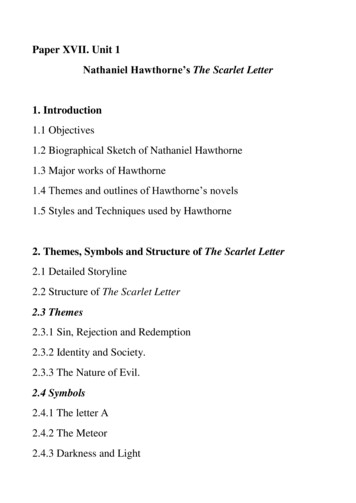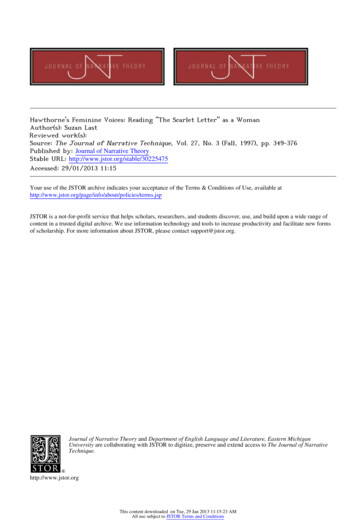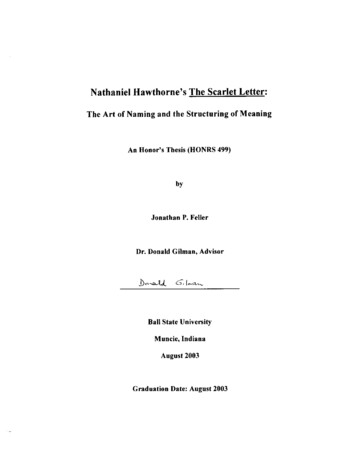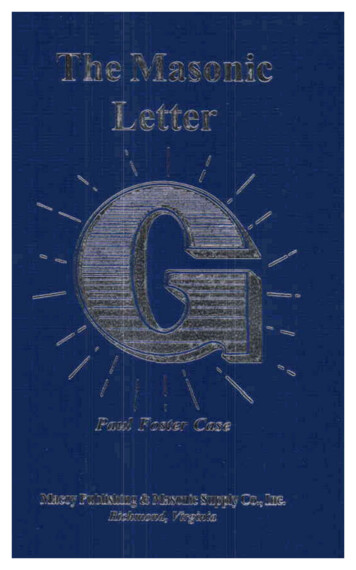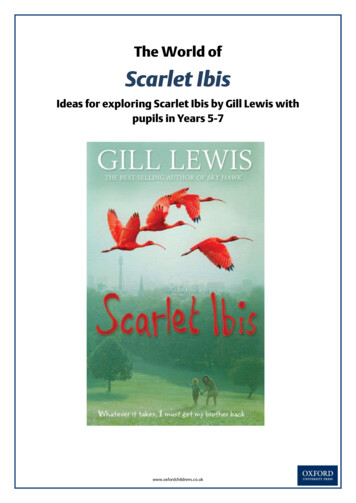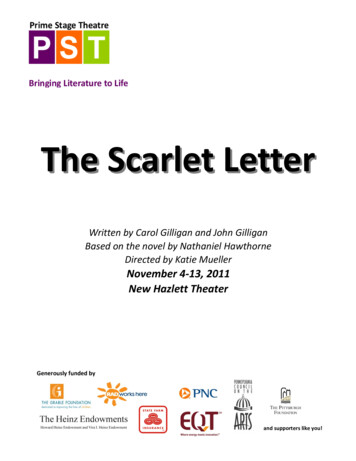
Transcription
The Scarlet LetterWritten by Carol Gilligan and John GilliganBased on the novel by Nathaniel HawthorneDirected by Katie MuellerNovember 4-13, 2011New Hazlett TheaterGenerously funded byand supporters like you!
FOR TEACHERS & STUDENTSPOST-SHOW CHAT SESSIONSStay after the school matinees to ask questions of both the actors and the characters! During the 20-minutepost-show chat sessions, delve into the minds and reasoning of the characters and then ask questions of theactors about the rehearsal process, theatre performance, and their experiences working on that particularproduction. No registration required.ADOPT-A-SCHOOL PROGRAMPrime Stage Theatre’s flagship education program strives to increase adolescent literacy through theatre inunderserved and underperforming school districts in the Western Pennsylvania area. In this FREE program,schools receive tickets and books for each Prime Stage production, 10 in-school workshops, and professionaldevelopment opportunities for teachers. If you would like your school to become involved, pleasedownload an application at our website, http://primestage.com/files/pdf/application aas.pdf.2011-12 PROFESSIONAL DEVELOPMENT WORKSHOPS — “CREATIVE INQUIRY FOR LITERACY LEARNING”Bring WONDER into your classroom by introducing creative inquiry into your lessons. Learn how theatre artists use questions and critical thinking in their work, and discover how to use these techniques to inspireyour students’ love of learning. This season there are three opportunities to expand your creative teachingskills and invigorate your practice: “Introduction to Creative Inquiry,” September 10, 2011 at the AlleghenyIntermediate Unit #3. “Engaging Disengaged Adolescents,” November 7, 2011 at the New Hazlett Theater.“Scientific Inquiry Is Not Just For Science,” April 23, 2012 at the Carnegie Science Center. For more information and registration form, visit http://primestage.com/educators students/workshops.html or contactChristina Farrell, Education Director at cfarrell@primestage.com.OPPORTUNITIES FOR TEENS, FAMILIES AND ADULTSPrime Stage Theatre offers opportunities for people of all ages to get involved with the theater. Check outour website to learn about mentorships, volunteering, book readings and many other exciting events. Thereis something for everyone at Prime Stage! http://primestage.com/
The Scarlet LetterResource GuideWelcome to Prime Stage Theatre:Bringing Literature to Life!09.01.2011Dear Educator,Antigone, PST2011The Glass Menagerie, PST 2011Welcome to the 2011-12 season at PrimeStage Theatre! We had a very successful season last year with acclaimed productions ofThe Legend of Sleepy Hollow, The Glass Menagerie and Antigone. We are thrilled to welcome you this year to three productions thatwill inspire you to imagine and discover: TheScarlet Letter, The Elephant Man and A Wrinkle in Time.This Resource Guide is designed to providehistorical background and context, classroom activities, and other curricular contentto help you enliven your students’ experience with the literature. We hope it will inspire you to use theatrical skills and creativethinking in your classroom in order to sparkpersonal connections with the themes andcharacters in the stories.If you have any questions about the information or activities in this guide, pleasedon’t hesitate to contact me. I’m happy to help and welcome your suggestions! Christina FarrellEducation Directorcfarrell@primestage.comCurriculum Connections CornerPrime Stage Theatre iscommitted to directlycorrelating our programsto the PDE AcademicStandards. The ScarletLetter and this resourceguide may be used toaddress the followingcurriculum content standards:Arts and Humanities:9.1-9.4Reading, Writing, Speaking, & Listening: 1.1-1.8History: 8.1-8.4Volume 3, Issue 1Resource Guide created byChristina Farrell for Prime StageTheatre. Please do not reproduceany part of the study guide forpublication without permission.Did you know Prime Stage Theatrehas been in existence forover 13 years. Prime Stage Theatre’svery first production wasA Woman Called Truthabout Sojourner Truth. Prime Stage Theatrefirst performed at theStation Square Playhouse(now Hard Rock Café).Check out what’s inside!The Scarlet Letter in 30seconds or Less!4Nathaniel Hawthorne4The Scarlet Letter by CarolGilligan and John Gilligan5Carol Gilligan5Putting it in Context6The Scarlet Letter in Art8Glossary9Pre-Reading and Pre-Show 10ActivitiesReading Activities11Post-Reading and PostShow Activities13Attending thePerformance14Resources and DiscussionQuestions15
The Scarlet LetterPage 4Summary—The Scarlet LetterThe Scarlet Letter in 30 seconds Hawthorne’s story begins in a Puritanvillage near Boston, Massachusetts in thesummer of 1642. A young and beautifulwoman named Hester Prynne has justbeen led from the prison, carrying herbaby daughter, Pearl. A red letter “A” hasbeen sewn onto her dress as a badge ofher shame. An old, hunched strangerappears in the crowd to ask about thewoman’s crime. He is told that Hester’shusband had stayed behind in Europe, butwas assumed lost at sea. However, Hesterbecame pregnant from an affair and, despite the urgent pleas from the churchelders, will not reveal the name of thebaby’s father.It is soon revealed that the old stranger isHester’s husband, a medicine man nowgoing by the name Roger Chillingworth. Heintroduces himself to Hester and says thathe can not blame her for being unhappymarried to an old, intellectual man. But heswears vengeance against her lover, vowing to discover his identity.Several years pass and although Hester isforced to live on the outskirts of the community, she supports herself through herseamstress work. She has even addedgolden embroidery to her red letter “A.”Pearl has grown into a willful and troublesome girl. The elders wish to take Pearlaway from Hester, but the eloquentpreacher Dimmesdale convinces themthat Pearl’s rightful place is with hermother.Although he is a respected leader in thecommunity, Dimmesdale appears to bewasting away. Chillingworth moves in withhim to take care of his health and soondiscovers a red letter “A” burned intoDimmesdale’s chest. Chillingworth realizesthe connection between Hester and thepreacher.Hester sees Dimmesdale’s deepening anguish and vows to help. They decide to runaway to Europe together after he delivershis final sermon. Just as he steps off thepulpit, however, he reveals the “A” on hischest and dies.Chillingworth dies a year later, frustratedthat he was not able to carry out his revenge. Hester and Pearl leave the villagefor a while, but Hester returns severalyears later with the “A” on her chest. Sheexchanges letters with Pearl, now marriedand raising her own family. Hester is buried next to Dimmesdale, a single letter “A”marking their shared tombstone.or less!A young Puritan woman is marked with aletter “A” for an adulterous affair leadingto the birth of a daughter. Her older husband vows to discover the identity of herlover and seek revenge. Her lover, thepreacher, suffers from his secret anguishand eventually dies from heartache.Nathaniel HawthorneNathaniel Hawthorne (July 4, 1804-May16, 1864) was born in Salem, Massachusetts to a family that descended from theearliest settlers of the Massachusetts BayColony. His ancestors included JohnHathorne, a harsh Puritan judge at the1692 Salem witch trials. This fact was bothintriguing and disturbing to Hawthorne,who later added a “w” to his name, perhaps to distance himself from his infamousrelatives.Hawthorne’s father, a sea captain, died ofyellow fever in 1808, so he and his twosisters were raised by his mother and herrelatives. He attended Bowdoin College inMaine where he became good friends withthe soon-to-be-famous poet HenryWadsworth Longfellow and future U.S.president Franklin Pierce.He began writing after college, withoutmuch initial success. He took a job as acustoms surveyor, but soon left the postto live in commune called Brook Farmwhich was designed to promote economicself-sufficiency and transcendentalist principles. In 1842 he married Sophia Pea-body and moved to “The Old Manse,” ahome in Concord, NH where Ralph WaldoEmerson once lived.During this time he began writing moreseriously. His collection of stories andessays about early America entitledMasses from an Old Manse caught theattention of the American literary community. They were looking for a fresh“American” voice to represent the newlyindependent country and Hawthorne’sstories, which were mainly about America’s Puritan roots, portrayed a uniquevision of the country and its people.Hawthorne published The Scarlet Letter in1850. The novel was praised by critics, butdidn’t earn widespread fame. His othermajor novels include The House of theSeven Gables (1851), The Blithedale Romance (1852), and The Marble Faun(1860).Franklin Pierce appointed Hawthorne aU.S. Consul in 1853. He traveled inEurope for six years and passed away in1864 shortly after returning home.Nathaniel Hawthorne, 1860’shttp://en.wikipedia.org/Transcendentalism was a religiousand philosophical movement of theearly nineteenth century dedicatedto the belief that divinity manifestsitself everywhere, particularly in thenatural world. It also advocated apersonalized, direct relationship withthe divine in place of formalized,structured religion. This second transcendental idea is privileged in TheScarlet s.html
Volume 3, Issue 1Page 5The Scarlet Letter by Carol Gilligan and John GilliganThe Scarlet Letter has remained a belovedstory for over a hundred and fifty years.During that time, many artists and performers have interpreted the novelthrough playwriting, visual art, dance andother media. Playwright Carol Gilligan,with her husband John, debuted this stageadaptation of Hawthorne’s story in 2002.The play begins by spotlighting variousmoments leading to Hester’s emergencefrom the prison. Hester writes a letter toher husband Roger, optimistically describing the land and society in the new world.He replies to tell her that he plans to leaveAmsterdam and join her soon. The sceneshifts and we see Hester and Dimmesdale’s romantic encounter, followed byHester’s imprisonment and appearance onthe scaffold with baby Pearl.Throughout the story, the adult Pearl reflects on her mother’s life and the choicesshe made. Her recollections serve as theframework for retelling Hester’s life. Manyevents are portrayed as they may havebeen understood through Pearl’s perspective.In Gilligan’s adaptation, Chillingworthmakes his first appearance on Pearl’s seventh birthday. He enters chatting withDimmesdale about the medicinal wisdomof the Algonquin tribe and discovers Hester defending her rights to raise Pearl tothe elders.Carol Gilligan writes, "Hawthorne's brilliant insight -- he is writing now in 1850, atthe time of Brook Farm and the Abolitionist Feminists -- was that the very qualitiesthat render a woman able to see the ironframework of society also disable her asan adulterated woman. He captures it allin the letter A, which, as the story explains, means Able as well as Adultery."Discuss with your students:How would you adapt TheScarlet Letter as a play?Is there anything unclear to you? Howcould you clarify details, emotions, symbols of themes? What is unnecessary?What is the most important message toyou? How could you bring that messageto the forefront for the audience?What questions remain unanswered in thenovel? How could you add scenes or dialogue to add to the story? Consider theevents that happened before or after theevents in the novel, or during the passageof time.Theater uses sight and sound! How couldyou use lighting, costumes, props, soundeffects or movement to tell the story?Carol GilliganCarolGilligan,Ph.D., is considered a pioneerwhose work continues to reframeour understanding of what itmeans to behuman.In 1982, Gilligan's groundbreaking andbestselling book, In a Different Voice: Psychological Theory and Women's Development, ushered in a new era of thinkingabout psychology and reshaped conversations about morality and ethics. Followingthe publication of In a Different Voice,Gilligan continued her exploration of psychological development in a variety ofdomains, including women's contributionsto psychological theory and education andthe relational worlds of girls. Her 1992book (with Lyn Mikel Brown), Meeting atthe Crossroads: Women's Psychology andGirls' Development, was a New York TimesNotable Book of the Year. Her 1996 book,Between Voice and Silence: Women andGirls, Race and Relationship (with JillMcLean Taylor and Amy Sullivan), studiedeconomically disadvantaged girls and theirstruggles to be heard and taken seriously.In her latest book, The Birth of Pleasure,Gilligan asks why we relive tragic stories ofloss and betrayal.With her students, Gilligan founded theHarvard Project on Women's Psychologyand Girls' Development and initiated theinnovative prevention projects: Strengthening Healthy Resistance and Courage inGirls, and Women Teaching Girls/GirlsTeaching Women. With Kristin Linklater,she directed The Company of Women, anall-women theater troupe that trainedwith companies of girls. Her preventionprojects expanded to include boys (theHarvard Project on Women's Psychology,Boys' Development, and The Culture ofManhood) and highlighted boys' ability toread the human emotional world accurately and to be empathic and selfreflective.A summa cum laude graduate of Swarthmore College, Gilligan earned a master'sdegree in clinical psychology from Radcliffe College in 1960 and a Ph.D. in socialpsychology from Harvard in 1964. Shebegan teaching at Harvard with the psychoanalyst Erik Erikson in 1967 and received tenure as full professor in 1986.From 1992-93, she was the Pitt Professorof American History and Institutions atthe University of Cambridge in England. In1997, Gilligan was appointed to a newlyendowed professorship at the HarvardGraduate School of Education, ThePatricia Albjerg Graham Chair in GenderStudies, Harvard's first position in genderstudies. Time magazine named her one ofthe 25 most influential Americans. Gilligan is currently a University Professor atNew York University with appointmentsin the Steinhart School of Education, theSchool of Law, and the Faculty of Arts andSciences. Gilligan is the recipient of manyawards including the prestigious Grawemeyer Award in Education, which honorsachievements in fields not recognized bythe Nobel prizes, such as education andmusic, and the Heinz Award for her contributions to understanding the humancondition.From: http://eomega.org/omega/faculty/
The Scarlet LetterResource GuidePage 6Putting it in ContextLife in Puritan New England:(From: http://www.ushistory.org/us/3d.asp)New England life seemed to burst with possibilities.The life expectancy of its citizens became longer than that of Old England, and much longer than the Southern English colonies. Childrenwere born at nearly twice the rate in Maryland and Virginia. It is often said that New England invented grandparents, for it was here thatpeople in great numbers first grew old enough to see their children bear children.Literacy rates were high as well. Massachusetts law required a tax-supported school for every community that could boast 50 or more families. Puritans wanted their children to be able to read the Bible, of course.Massachusetts Bay Colony was a man's world. Women did not participate intown meetings and were excluded from decision making in the church. Puritanministers furthered male supremacy in their writings and sermons. Theypreached that the soul had two parts, the immortal masculine half, and the mortal feminine half.Puritan law was extremely strict; men and women were severely punished for avariety of crimes. Even a child could be put to death for cursing his parents.It was believed that women who were pregnant with a male child had a rosycomplexion and that women carrying a female child were pale. Names of womenfound in census reports of Massachusetts Bay include Patience, Silence, Fear,Prudence, Comfort, Hopestill, and Be Fruitful. This list reflects Puritan views onwomen quite clearly.Mary Dyer led to execution on Boston Common, 1660Church attendance was mandatory. Those that missed church regularly weresubject to a fine. The sermon became a means of addressing town problems orconcerns. The church was sometimes patrolled by a man who held a long pole. On one end was a collection of feathers to tickle the chins ofold men who fell asleep. On the other was a hard wooden knob to alert children who giggled or slept. Church was serious business indeed.The Puritans believed they were doing God's work. Hence, there was little room forcompromise. Harsh punishment was inflicted on those who were seen as strayingfrom God's work. There were cases when individuals of differing faiths werehanged in Boston Common.Made famous by author Nathaniel Hawthorne in his book of the same name, theScarlet Letter was a real form of punishment in Puritan society. Adulterers mighthave been forced to wear a scarlet "A" if they were lucky. At least two known adulterers were executed in Massachusetts Bay Colony. Public whippings were commonplace. The stockade forced the humiliated guilty person to sit in the publicsquare, while onlookers spat or laughed at them.Puritans felt no remorse about administering punishment. They believed in OldTestament methods. Surely God's correction would be far worse to the individualthan any earthly penalty.Young man in the stocksContrary to myth, the Puritans did have fun. There were celebrations and festivals.People sang and told stories. Children were allowed to play games with their parents' permission. Wine and beer drinking were common place. Puritans did not alldress in black as many believe. The fundamental rule was to follow God's law.Those that did lived in peace in the Bible Commonwealth.
Volume 3, Issue 1Page 7Putting it in Context (cont.)Puritan Religious Beliefs:(Adapted from: http://www.nd.edu/ rbarger/www7/puritans.html and http://public.wsu.edu/ campbelld/amlit/purdef.htm)The Puritan religion developed out of dissatisfaction with the Church of England.Its members believed that the Church of England was polluted by politics and manmade doctrines, so they strove towards religious, moral and societal reforms. Theirname stems from their desire to “purify” the church and bring it back to its foundation in the Bible. Whereas the Church of England believed in the church’s authority to determine one’s salvation, the Puritans believed that God alone coulddetermine one’s fate. The Puritans rejected the symbols and rituals of the highchurch. In order to escape persecution for their dissent against the church leadership and the King, they came to America. As the Puritans settled in the New England area, their numbers rose from 17,800 in 1640 to 106,000 in 1700. As theydealt with the challenges of living in an untamed, foreign land, their spiritual bondhelped them survive.Each church congregation was to be individually responsible to God, as was eachperson. People of opposing theological views were asked to leave the communityor to be converted. Unlike Catholic or Anglican churches, the Puritans did not believe that every person in the parish had the right to be a full church member. In order to be elected as a full church member, applicantssubmitted narratives describing their relationship with God.Their interpretation of the Bible was strict and harsh. They felt that although God could forgive anything, man could forgive only by seeing achange in behavior. Actions spoke louder than words, so actions had to be constantly controlled. Although Puritans believed that God hadpredetermined whether they would be sent to heaven or hell, they had no way of knowing which group they were in. Therefore, theyworked to do good in this life in order to be chosen for the next eternal one.The Puritans believed that the devil was behind every evil deed. Eloquent ministers warned the persuasiveness of the devil's power. Childrenwere constantly reminded of the devil’s the presence and were quizzed on Bible athome and school. The education of the next generation was important to further"purify" the church and perfect social living.When the Puritans traveled from England, they left some popular pastimes behindthem; drama, religious music and erotic poetry. Drama and poetry were considered topromote immorality. Music in worship created a "dreamy" state which was not conducive in listening to God. Instead, they passed their time by reading the Bible anddiscussing the Greek classics of Cicero, Virgil, Terence and Ovid. They were encouraged to create their own poetry, as long as it was religious in content.Puritan Education:Puritans formed their first formal school in 1635, which was the first free schoolingfor children in history. Four years later, the first American College was established;Harvard in Cambridge. The first printing press arrived in 1638 and by 1700 Bostonbecame the second largest publishing center of the English Empire. The Puritans werethe first to write books for children, and to consider how to communicate appropriately with children. At a time when other Americans were physically blazing trailsthrough the forests, the Puritans efforts in areas of study were advancing our countryintellectually."Without the heart it is no worship. It is a stage play.It is an acting of a part without being that person,really. It is playing the hypocrite."STEPHEN CHARNOCK, Puritan Theologian
Page 8The Scarlet LetterResource GuideThe Scarlet Letter in ArtLillian Gish in TheScarlet Letter film,1926Demi Moore and GaryOldman in The ScarletLetter film, 1995Penguin Classics“fashion” bookcoverThis work, by Kim Radatz, is titled "The Scarlet Letter (99Lashes)". It refers, in part, to the story of an Iranian womanthat was facing stoning for the crime of adultery. It is adelicate dress, with bright, blood-red accents around thecollar, and running down its length to the stones below.The Iranian penal code specifies that the guilty are to bepartially buried, and the stones to be used must not be toobig, "so as not to kill the victim immediately" (quote takendirectly from KR's tag for the com/Nathaniel Hawthorne, regarded this painting by Hugues Merle in 1859, as the finest illustration of his novel. Arthur Dimmesdale and Roger Chillingworth appear in the background.Merle’s canvas reflects some of the same 19th-century historical interest in the Puritans asHawthorne’s book, a fascination that reached its peak with the establishment of Thanksgiving as a national holiday in 1863. By depicting Hester and her daughter, Pearl, in a pose thatrecalls that of the Madonna and Child, Merle underlines The Scarlet Letter’s themes of sinand redemption.http://art.thewalters.org/ In the Tool song “The Grudge” the line 'Unable to forgive your scarlet letterman' is areference to the novel.In the Hole recording of “Old Age” there is a lyric "no one knows she's Hester Prynne".The band Jars of Clay have a song entitled “Scarlet” on their album The Eleventh Hour,which refers to the novel.The band Casting Crowns alludes to The Scarlet Letter in “Does Anybody Hear Her” fromLifesong, "They can't see past her scarlet letter, and we've never even met her".The 1993 novel, The Holder of the World by Bharati Mukherjee re-wrote the story, placing it in present day Boston, Colonial America, and seventeenth century India during the spread of the British East India Company.In the novel Speak, Hairwoman, the English teacher, refers to The Scarlet Letter in her lesson. The novel's protagonist is a freshmanin high school who is ostracized from her fellow schoolmates during the school year, much as Hestery Prynne was ostracized.The Music Man character Harold Hill sings a line in the song "The Sadder But Wiser Girl" about his desire for a strong-willed woman:"I smile, I grin, when the gal with a touch of sin walks in. / I hope, and I pray, for a Hester to win just one more 'A'."From: http://www.search.com/reference/The Scarlet Letter
Volume 3, Issue 1Page 9What is What?!?CONTAGION: the spread as of an idea, emotionCONTUMACIOUSLY: stubbornly disobedient:Hawthorne uses a rich and complex lanrebellious.guage throughout The Scarlet Letter, WeCONTUMELY: rude language or treatment arisinghave listed some of the words that arefrom haughtiness and contempt.infrequently utilized today.DEARTH: scarcity, lack, or famine.DENIZENS: an inhabitant: resident.Have students record unfamiliar words asEMBOWED: arched.they encounter them while reading theEMOLUMENT: advantage.book. Students should then look up definiEPOCH: a point in time marked by the beginningtions in a dictionary. Vocabulary activitiesof anew development or state of things.ERUDITION: extensive knowledge acquiredcould include a word wall, word ball orchiefly from books.new sentence generation.ESCUTCHEON: a protective or ornamental shield.EXIGENCES: a state of affairs that makes urgentPDE Academic Standards 1.7-1.8demands.EXTANT: not destroyed or lost.ADDUCED: to bring forward as in argument or as FAIN: ratherevidence.FARTHINGALE: a support worn in the 16th cenALLOY: to reduce the purity of by mixing withtury beneath a skirt to expand it at the hip line.something debasing.GALLIARD: gay, lively.ANIMADVERSION: adverse and typically illGULES: the heraldic color rednatured or unfair criticism.HALBERDS: a weapon consisting typically of aANTINOMIAN: one who rejects a socially estab- battle ax and pike mounted on a handle aboutlished morality.six feet long.APOTHEOSIS: elevation to divine status.HEATHENISH: barbarous.APPELLATION: an identifying name or title.HETERODOX: holding unorthodox opinions orARMORIAL: relating to or bearing heraldic arms. doctrines.ASPERITY: roughness of manner or of temper.HEWN: strictly conformed.AUGURED: foretold.HORNBOOK: a child's reading book consisting ofBAGGAGE: a contemptible woman; prostitute.paper protected by a sheet of transparent horn.BEDIZEN: to dress in a gaudy or vulgar manner.IGNOMINOUS: shameful.BENEFICENCE: an office to which the revenueINDEFATIGABLE: incapable of being fatigued.from an endowment is attached: fief.INDEFEASIBLE: not to be annulled or made void.BOON: a favor sought.INIMICAL: hostileBROADSWORD: a sword with a broad blade forLEES: the settling of liquor during fermentationcutting rather than thrusting.and aging: dregs.BUCKLER: a shield worn on the left arm.LOQUACITY: exceedingly talkative.CABALISTIC: esoteric doctrine or mysterious art. MACHINATION: a scheming action or artful deCAPRICE; a sudden, impulsive change: whim.sign intended to accomplish some evil end.CHIRURGICAL: surgical.MALEFACTRESSES: a person who violates the lawCHOLERIC: bad tempered; irritable.or does evil.CLARION: a clear, shrill medieval trumpet.MALIGNANT: disposed to cause deliberate harm.CLEW: clue.MEED: a fitting return or recompense.COLLOQUY: an especially formal conversation.MISANTHROPY: a hatred or distrust of mankind.COMMODIOUSNESS: comfortable or convenMORION: high-crested helmet with no visor.iently spacious: roomy.MOUNTEBANK: any charlatan or quack.GlossaryMUSTER: formal military inspection.NECROMANCER: a person who is believed tocommunicate with the spirits of the dead forpurposes of magically revealing the future ofinfluencing the course of events.NUGATORY: having no force: inoperative.ODIOUS: exciting or deserving hatredOBEISANCE: a bodily gesture, as a bow, expressing respect.OBVIATED: to dispose of; making unnecessary.PANOPLY: full suit of armor.PARAMOUR: an illicit lover.PERADVENTURE: perhaps.PHANTASMAGORIC: constantly changing scene.PHYSIOGNOMIES: the facial features held toshow qualities of mind or character by theirconfiguration or expression.PLEBEIAN: one of the common people.POTENTATE: one who wields controlling power.PROGENITORS: an ancestor in the direct line:forefather.QUAFF: to drink (a beverage) deeply.REGIMEN: to organize.REMONSTRANCE: objection.SAGAMORES: a subordinate chief of the Algonquian Indians of the north Atlantic coast.SCROFULA: a form of tuberculosis.SCURRILOUS: grossly and offensively abusive.SEDULOUS: diligent in application or pursuit.SEPULCHRES: burial vault built of rock or stone.SERE: withered.SOMNAMBULISM: sleepwalking.SOMNIFEROUS: hypnotic.SUMPTUARY: designed to regulate habits onmoral or religious grounds.TROW: believe.TRAMMELED: something that restricts activity orfree movement: hindrance.UNFEIGNEDLY: not pretending.VENERABLE: made sacred especially by religiousor historical association.VICISSITUDE: unexpectedly changing circumstances.WORMWOOD: something bitter and grievous:bitterness.WOTTEST: to have knowledge of or to know.John Winthrop (1587-1649) was the first governor of the Massachusetts Bay colonyand served as governor for twelve (nonconsecutive) terms. A self proclaimed "Saint ofGod", Winthrop became angered in 1636 when Anne Hutchinson (1591-1643) beganto hold Bible study meetings in her home which offered her own interpretations ofthe scripture, including the story of Adam and Eve. She spoke against inequality forwomen, racial prejudice and the legal authority of the clergy. For these beliefs, shewas charged with ANTINOMIANISM, as well as "lewd and lascivious conduct" forhaving men and women in her house at the same time during her Sunday meetings.Hutchinson was eventually banished from the colony and her the Puritan Church. Shemoved to Portsmouth, Rhode Island and is still considered one of the leaders inwomen’s rights and religious freedom.
Page 10The Scarlet LetterPre-Reading and Pre-Show ActivitiesPrime Stage’s mission, bridging literature, life and learning, encourages students to approach literature with curiosity and personal relevance. The activities below are intended to spark enthusiasm, interest and inquiry intothe story before they have read the text or atte
The Scarlet Letter in 30 seconds or Less! 4 Nathaniel Hawthorne 4 The Scarlet Letter by Carol Gilligan and John Gilligan 5 Carol Gilligan 5 Putting it in Context 6 The Scarlet Letter in Art 8 Glossary 9 Pre-Reading and Pre-Show Activities 10 Reading Activities 11 Post-Reading



